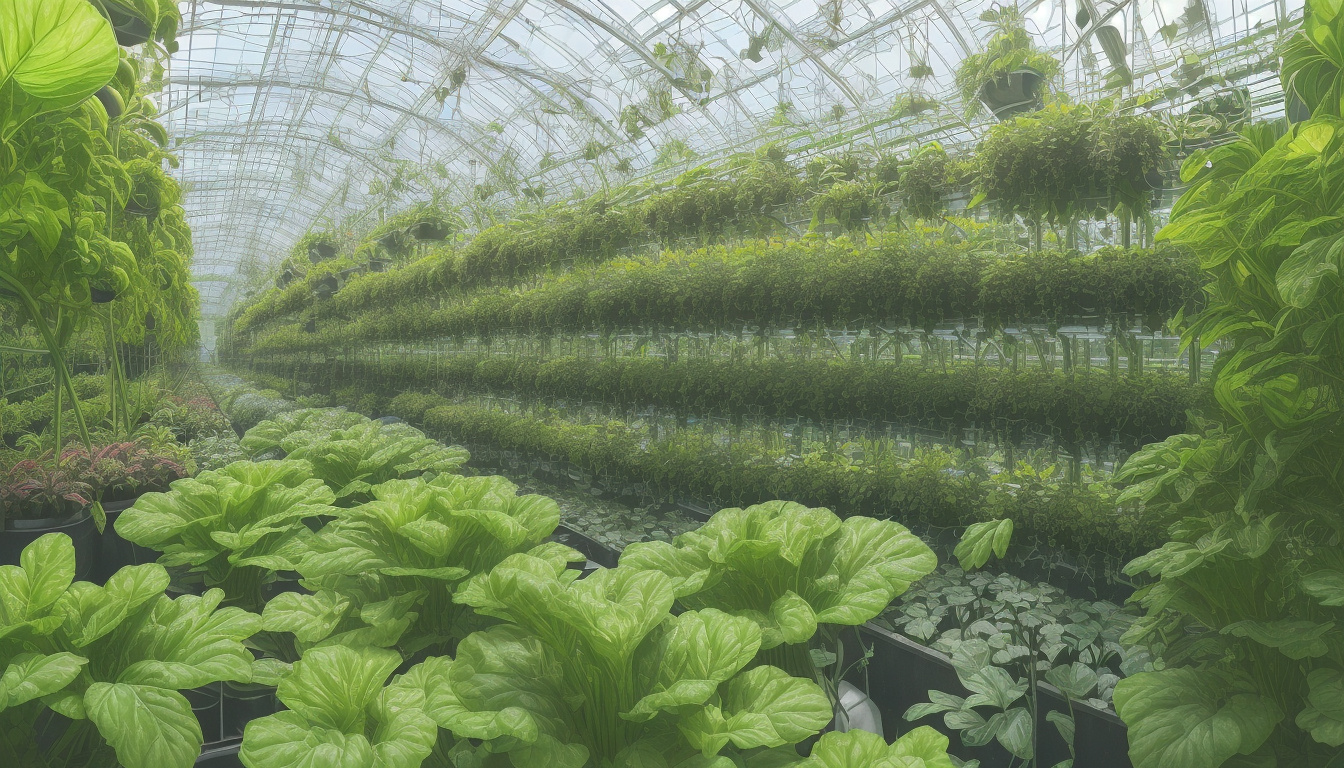Unlocking the Future of Farming: A Comprehensive Guide to Hydroponics

Are you curious about how to grow plants without soil? Welcome to the world of hydroponics! This innovative farming method is gaining popularity among health enthusiasts, farmers, and anyone interested in sustainable agriculture. In this guide, we'll dive into what hydroponics is, explore its impressive benefits, and look at the equipment you'll need to get started. Whether you're a seasoned farmer or a curious consumer, understanding hydroponics could be the key to unlocking a more sustainable future for our food systems. Let's explore why hydroponics is more than just a trend—it's a revolution in farming!
Interested in our Digital Magazine APP?

Here's a thought
- Hydroponics is a method of soilless farming that allows plants to grow in nutrient-rich water.
- This farming technique offers numerous benefits, including faster growth rates and reduced water usage.
- Investing in the right equipment is crucial to successfully set up a hydroponic system.
- Different hydroponic systems cater to various needs and preferences, making it important to choose wisely.
- Emerging innovations in hydroponics are paving the way for more sustainable and efficient farming practices.
What is Hydroponics? An Introduction to Soilless Agriculture
If you're curious about innovative ways to grow food, have you ever heard of hydroponics? Hydroponics is a method of soilless agriculture that allows plants to thrive in nutrient-rich water instead of traditional soil.
This system is fascinating because it gives farmers and hobbyists alike the ability to cultivate fresh veggies and herbs in various environments, whether indoors or in urban settings.
Imagine being able to grow crisp lettuce or fragrant basil right in your kitchen! One of the biggest advantages of hydroponics is that it often uses less water than conventional farming, making it an eco-friendly option that also maximizes space.
For health enthusiasts, hydroponics makes it easier to access organic produce without harmful pesticides since you can control the growing conditions precisely. Plus, homemade hydroponic setups can be a fun project for families looking to bond over gardening experiences.
So, if you’re a consumer wanting fresher food options, a health enthusiast seeking organic produce, or a farmer exploring new methods, hydroponics might just be the sustainable choice you’re looking for.
The Benefits of Hydroponics: Why Choose This Farming Method?
When it comes to modern farming methods, hydroponics stands out as a revolutionary technique that offers numerous benefits for health enthusiasts, consumers, and farmers alike. By growing plants in a nutrient-rich water solution rather than soil, hydroponics enables faster growth rates and higher yields — perfect for those looking to enjoy fresh, nutrient-dense produce.
For health enthusiasts, the appeal lies in knowing that hydroponically grown vegetables are often free from harmful pesticides and are grown in a controlled environment, which translates to cleaner and safer food options.
Meanwhile, farmers can take advantage of reduced water usage and less land space, making it an ideal solution for urban farming or areas with limited arable land. Plus, with the growing demand for local and sustainable food, hydroponics can help farmers meet consumer preferences while also contributing to environmental sustainability.
So, whether you’re a consumer seeking healthier food options, a health conscious individual, or a farmer interested in innovative techniques, hydroponics is definitely worth considering!
'The future of agriculture is in using smart technologies, sustainable practices, and innovative techniques like hydroponics to feed a growing population.' - Unknown
Essential Equipment and Supplies for Hydroponic Systems
If you’re venturing into the world of hydroponics, understanding the essential equipment and supplies is crucial for a successful setup. Hydroponics, the method of growing plants without soil, relies on a few key tools to thrive.
First off, you'll need a reliable grow system—whether it's deep water culture, nutrient film technique, or an aeroponic setup. Each system has its own benefits, so choose one that fits your space and plants' needs.
Next up is a nutrient solution; specialized fertilizers provide essential minerals typically found in soil, ensuring your plants get all the nutrients they crave. Don't forget about grow lights if you're not blessed with natural sunlight; LED lights offer efficiency and longevity, making them perfect for indoor growing.
Additionally, pH and EC meters help you monitor your water's quality, keeping the nutrient absorption optimized. Finally, invest in a good water pump to ensure nutrient flow and an air pump to oxygenate the water—a vital aspect of any hydroponics system. With these tools, you’ll be well on your way to cultivating healthy plants in your hydroponics garden!
Interested in our Digital Magazine APP?

Different Types of Hydroponic Systems: Choosing the Right One for You
When it comes to exploring the world of hydroponics, it’s essential to understand the different types of systems available, as each one offers unique benefits that can cater to varying needs. For home gardeners looking to grow fresh herbs and vegetables right in their kitchens, a simple deep water culture (DWC) system might be the way to go.
Alternatively, if you’re a health enthusiast interested in maximizing yield and efficiency while minimizing space, consider the nutrient film technique (NFT) which continuously recirculates nutrient-rich water to the roots of plants.
Farmers might lean towards aeroponic systems, where plants are suspended in air and treated to periodic misting of nutrients, allowing for faster growth and reduced water usage.
It’s vital to weigh the advantages and challenges of each hydroponic system, so that you can choose the one that aligns perfectly with your goals—whether that's sustainable home gardening, enhancing your health with fresh produce, or increasing your agricultural output!
Common Challenges in Hydroponics and How to Overcome Them
When diving into the world of hydroponics, many enthusiasts, consumers, and farmers face common challenges that can hinder their success. One of the most frequent issues is nutrient imbalances, which can lead to poor plant growth or even crop failure.
To overcome this, it’s crucial to regularly test your nutrient solution and adjust your feeding regimen accordingly. Another challenge is the risk of pests and diseases, as hydroponic systems can create a humid environment perfect for pathogens. Implementing organic pest control methods and maintaining a clean system can help mitigate this risk.
Lastly, beginners often struggle with the technological aspect of hydroponics, such as managing pH and water levels. Investing in reliable monitoring equipment, such as pH meters and automated irrigation systems, can simplify these tasks. By addressing these common challenges in hydroponics, you empower yourself to cultivate a thriving indoor or outdoor garden with ease.
Here's something people ask about
What is hydroponics?
Hydroponics is a method of growing plants without soil, using mineral nutrient solutions in water. It allows for efficient plant growth and higher yields compared to traditional farming.
What are the benefits of hydroponics?
Hydroponics offers numerous benefits, including improved growth rates, less water usage, space efficiency, and the ability to grow crops year-round, making it a sustainable farming choice.
What equipment do I need to start a hydroponic system?
Essential equipment includes growing containers, a water reservoir, a pump, a nutrient solution, and grow lights if you're growing indoors, among other supplies depending on the system you choose.
What types of hydroponic systems are available?
There are several types of hydroponic systems, including nutrient film technique (NFT), deep water culture (DWC), aeroponics, and drip systems. Your choice will depend on your available space, budget, and the crops you wish to grow.
What challenges do hydroponic growers face?
Common challenges in hydroponics include maintaining nutrient balance, managing water quality, dealing with pests, and ensuring proper lighting. These can be addressed through regular monitoring and by implementing best practices in system management.
We're striving to bring a range of different topics that relate to the Farming Food & Health sector. If you've got a question, please feel free to contact us.
We publish a quarterly magazine available in IOS, Android and Web reader. Stories and articles curated from amazing people all around the world.






